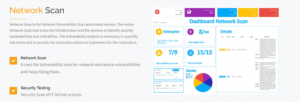Network Vulnerability Scan
A network vulnerability scan is a tool to detect vulnerabilities in your network. These tools identify any actions or system settings that could allow a hacker to take advantage of your network. These scanners are non-intrusive and can help you detect security issues before they become an issue. They also provide a logged summary of the alerts they identify.
network vulnerability scans can monitor web servers, operating systems, daemons, and other services that are exposed to the Internet. They compare their findings to a database of known vulnerabilities. Many vulnerability databases use the Common Vulnerabilities and Exposures (CVE) Program catalog to list potential vulnerabilities. Each record includes a unique CVE identifier, a short description, and at least one public reference.

In order to maximize the chances of discovering security vulnerabilities, vulnerability scanners should include whitelisting. This is a process whereby the scanner will detect vulnerabilities in software without requiring remote access. This can help mitigate security threats, including malware and hackers. In addition, security scanners should include IPS systems and other protective technologies like WAFs. However, these technologies are not infallible, and hackers can use a variety of techniques to bypass them.
What is a Network Vulnerability Scan?
Network vulnerability scanning can be performed in two different ways – externally and internally. An external vulnerability scan identifies weaknesses in the network infrastructure, while an internal vulnerability scan targets web applications and open ports. Both methods identify security flaws that a hacker can exploit. A network vulnerability scan can also be conducted using an authenticated scanner.
Network vulnerability scanners are a necessary part of a proactive security program. They can identify and prioritize vulnerabilities across a network. They can also provide a barometer for the security team’s progress in remediating flaws. These scanners are used by IT departments around the world to prevent data leaks and other security threats. However, some people are still confused about the importance of using a network vulnerability scanner.
Network vulnerabilities are a common source of security breaches. A single weakness could allow an attacker to compromise a company’s system and access customer information. This can lead to huge costs, and it can cause operational problems. Further, a breach could negatively impact the reputation of the company. In addition, it could expose them to hefty fines.
A network vulnerability scan can identify weaknesses in the network’s software, applications, and endpoints. It also determines whether any countermeasures are effective. Usually, vulnerability scanners should run once per week against an enriched database of vulnerabilities. A web vulnerability scan is similar to a network vulnerability scan, but it scans the code of a website. It can detect vulnerabilities that compromise the application, and it is an essential part of an application security testing program.